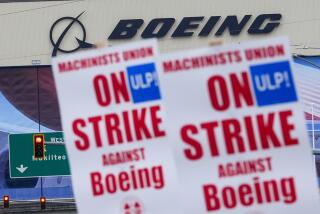Winds of Change Hamper Unions’ Bid for Rise in Pay : Employers Push for Concessions, Low Wage Hikes
Many of the nation’s major employers will attempt to hold down wage increases to the 2% to 4% level and demand work rule concessions from unions to increase productivity in what promises to be a heavy year of collective bargaining.
Contracts covering 3.8 million workers expire in 1986 in industries including aerospace, construction, oil refining, farm machinery, state and local government, steel and telecommunications, according to the Labor Department’s Bureau of Labor Statistics.
A survey by the Bureau of National Affairs (BNA), a Washington-based research organization, noted that many companies will seek the elimination of cost-of-living adjustment clauses, press for health-care cost containment and try to gain two-tier wage structures, which set lower rates for newly hired employees but leave intact the wages of veteran workers. Many corporations also will offer yearly lump-sum bonus payments that do not increase the hourly base wage.
In lieu of major wage increases, unions will be pressing hard for job security gains such as restrictions on the contracting out of work, opportunities for employees to get new jobs in the company and retraining for workers so that they can perform new tasks at a firm that is changing operations.
Many employers, however, indicate that they have no plans to improve existing contract provisions, according to the BNA report.
Labor economist Audrey Freedman said her research concurs with BNA’s on the low level of wage increases.
She estimated that union wage gains would average 3.5% this year, less than the anticipated inflation rate of 4%. “We’re not going to see any rockets take off anywhere in bargaining this year,” she said.
Two of the most significant negotiations will come to a head in August, when labor agreements covering 330,000 telephone workers employed by seven regional Bell companies formerly owned by American Telephone & Telegraph expire and when contracts covering 220,000 steelworkers at six large companies come due. The contracts of another 170,000 telephone workers employed by AT&T; also were due to expire Aug. 9, but on Friday the Communications Workers of America announced that it had reached an agreement with the company to allow the contract to expire May 31. The union will begin negotiating on a new contract with AT&T; in April and hopes to have it resolved by the end of May so that it can then concentrate on talks with the regionals, which are expected to be more difficult.
There could be dramatic changes in labor relations in both steel and telecommunications.
“Both situations are further examples of the breakup of past bargaining arrangements,” said Freedman of the Conference Board, a New York-based business research organization.
The old custom of initially reaching an agreement with one company and using that contract as a model for negotiations with other firms in the industry, a practice known as pattern bargaining, has ended in the steel industry. And this will be the first set of major contract negotiations held in the telecommunications industry since AT&T;’s divestiture of many of its operating units in 1984.
“This industry has been hit by four factors all at once--divestiture, deregulation, foreign competition and rapidly changing technology. I don’t know of any other industry where this happened simultaneously,” said Roseann Weissman, public relations director for the Communications Workers.
“All these things are having on impact on jobs. We’re going into bargaining in a climate of layoffs, which we’ve never had in large numbers before,” she added.
Whole New Ballgame
Last week, the Communications Workers’ bargaining councils met to plan strategy. Some of the parameters already have been set. For the past decade, the union conducted coordinated bargaining on all major issues with AT&T; officials, with some specific matters left to local negotiations. Now it’s a whole new ballgame.
The CWA will hold separate talks with a smaller AT&T; and the seven regional companies that were formed by divestiture. At least three of the regionals, Philadelphia-based Bell Atlantic, Denver-based U S West and Chicago-based Ameritech are insisting that the union negotiate separately with their wholly owned subsidiaries.
Among them, those three regionals own 14 operating companies. Morton Bahr, the CWA’s president, continues to insist on regional bargaining.
The union fears that bargaining with individual companies might result in variations in pensions and other benefits that could lead to friction in the union.
Bahr has said that, if the union does not get regional bargaining in those three areas, it will target a particular company, establish a pattern-setting contract there and then negotiate a similar deal at the other companies.
Divestiture also has presented the union with another long-term dilemma, noted Daniel Mitchell, director of the UCLA Institute of Industrial Relations.
The basic operating companies are still regulated monopolies at the local level. However, all of the regional companies have newly formed subsidiaries in the unregulated areas of the business, most of which are non-union operations.
Could Lose Grip
“If the union relies on the ability of the regulated companies to pass along wage increases to set the basic level of wages in the industry (regulated and unregulated), it could lose its grip on the competitive sector,” Mitchell said.
“On the other hand, permitting (wage) diversity could weaken its bargaining stance in the regulated sector. And setting a wage across the board based only on the sector exposed to competition would mean a sacrifice of the bargaining power of many members.
Thus, the union must make a strategic decision in 1986 about its long-term wage and organization policies.”
The issues in the steel talks promise to be just as complicated.
The industry, buffeted by low-wage foreign competition, the strong dollar and a host of other problems, is operating at only 60% of capacity.
The steel companies will be attempting to lower their labor costs in these negotiations. Some of them may try to lower costs by as much as $5 an hour, as Wheeling Pittsburgh did last year after filing for protection from creditors under Chapter 11 of the U.S. Bankruptcy Code.
The United Steelworkers has shown some willingness to accommodate the needs of the steel companies, said Ben Fischer, director of labor studies at Carnegie Mellon University in Pittsburgh.
He said that, over the past several years, the union has gradually disassembled the so-called pattern in steel contracts by making agreements to rescue various companies and plants that were financially ailing.
Will Push for Relief
The union has let it be known it does not plan to grant the same kind of concessions to profitable companies like U.S. Steel. But other companies in the industry, such as LTV and Bethlehem, are financially ailing and will push the union for relief.
“The union is going to be hard pressed to operate between its desire for some degree of a pattern or fairness, both as to company and employees, in an environment in which companies are going to be striving for arrangements they consider essential to survival,” Fischer said.
The problems of the domestic steel industry cannot be solved solely at the bargaining table, said Lynn Williams, the United Steelworkers’ president, in a recent speech to the Industrial Relations Research Assn. in New York.
He said the industry’s customers, the financial community and the federal government must work together to reach some comprehensive solutions. Fischer said he agrees with that critique but noted that it is quite unlikely to occur in the near future.
Workers in the building trades also will face tough sledding in keeping up with inflation, Freedman said. “The competition from non-union construction is still very strong,” she said.
Indeed, the major issue in nearly 100 contract negotiations to be conducted this year by the Sheet Metal Workers “will be the non-union problem,” said Edward J. Carlough, the union’s president.
Authorizes Concessions
He said that, over the past several years, the union had negotiated a number of contract changes to keep companies competitive.
In fact, he said, there is now a section of the Sheet Metal Workers’ constitution that authorizes union business agents to make concessions on a job-by-job basis.
“It’s been very successful,” he said. “In the first three quarters of 1985, we got 5 million more man-hours of work than we would have if we hadn’t done this.”
For example, he said the union garnered $20 million worth of work on an R. J. Reynolds construction project in North Carolina. The initial fabricating work was done in Pittsburgh.
“Wages and fringe benefits weren’t touched there,” he said. “But we gave the employer a number of extra apprentices and pre-apprentices at lower wage rates. In North Carolina, we reduced the wage rate by 15%.”
Carlough said the union would be making similar arrangements in talks this year, depending on local conditions. “There won’t be any national pattern,” he said.
Workers in the oil refining industry aren’t sure whether they have a national pattern this year, said Jerry Archuletta, a spokesman for the Oil, Chemical & Atomic Workers.
The union’s contracts, covering 46,500 workers at the nation’s major oil companies expired last Wednesday but union members continued to work as negotiations dragged on.
The union is asking for a substantial wage increase for each of the next two years, additional contributions from the companies for health-care insurance and contract language that would further protect workers in the event of plant closures or layoffs, Archuletta said.
He said job security was quite important to the union because it had lost 10,000 jobs as a result of 127 refineries closing since 1980. Thus far, he said, the union has received little response from any of the major companies.
No Lead Company
In the past, Archuletta said, one of the majors, usually Gulf Oil, gave a detailed response by Dec. 15. But Gulf was purchased last year by Chevron, and thus far no lead company has emerged.
By late last week, the union had rejected offers from several major oil companies, including Amoco, Atlantic Richfield, Ashland, Chevron, Phillips, Shell, Tenneco and Unocal.
Amoco’s offer included a $700 lump-sum payment in lieu of a wage increase in the first year and a 1% wage increase in the second year. The other firms made similar offers, the union said.
There are also disagreements on non-wage issues.
“They’re talking about job security. We’re talking about increased efficiency,” Chevron spokesman Mike Marcy said.
Asked if that meant work rule changes, he agreed but would not elaborate. Neither side said they expect a strike in the highly automated industry, which last saw a national walkout in 1980.
Spokesmen for McDonnell Douglas and the United Auto Workers said they did not expect a strike this October, unlike three years ago when several thousand UAW members at the company’s Douglas Aircraft plant in Long Beach left their jobs for 115 days in an unsuccessful attempt to stave off concessions that the company was demanding.
The settlement of the bitter strike provided that workers would get a 3% lump-sum bonus payment each year of the three-year contract in lieu of the normal wage increase. It also established a two-tier wage system.
Concerted Effort
“I think we’ve come a long way in our labor relations since 1983-84,” company spokesman Don Hanson said. “There’s been a concerted effort on both sides to try to find ways to deal better with each other, and I think it’s been very successful.”
Hanson and Bob Berghof, president of UAW Local 148, said there had been extensive discussions on consummating a gain-sharing agreement whereby any increases in productivity and profits would be shared between the company and its employees.
Berghof said that considerable progress had been made but that the union was currently at loggerheads with the company over the UAW’s position that it be allowed to have its own financial consultant present at meetings where the gain-sharing formula would be devised.
“The formula is the key,” Berghof said. “We need some knowledgeable people in there on our behalf.”
He said he anticipated that the union’s bargaining position would be stronger this fall than it was three years ago because the company is profitable now, its business is expanding rapidly and, as a consequence, union membership has risen sharply.
At the start of 1983, the UAW represented 4,800 workers at Douglas, he said, and now it has 7,800.
That is likely to rise by close to 3,000 employees this year with Douglas having just won a $3.39-billion Air Force contract to develop the C-17 military cargo plane.
“I think the company will see the light to come up with an equitable contract,” Berghof said. “Failing that, there will be trouble.”
Major Bargaining Issues
In the public sector, contracts covering 738,000 state and local government workers come up this year.
Attempts to garner wage increase and to hold down health-care costs without burdening employees will also be issues in this arena, said Don Wasserman, director of collective bargaining services for the American Federation of State, County & Municipal Employees (AFSCME) which represents more than 1 million workers across the country.
He also said that in many areas a key issue will be pay equity--the attempt to gain equal pay for women in female-dominated jobs that pay less than male-dominated jobs of comparable worth.
There currently are a number of pending state and federal court lawsuits on the issue, including one filed by the California State Employees Assn. against the state of California.
On Dec. 31, AFSCME announced that it had reached a settlement in its pay equity case against the state of Washington that provided for distribution of about $482 million to 34,000 state employees over the next six years to correct gender-based inequities in the state’s wage scales.
More to Read
Sign up for Essential California
The most important California stories and recommendations in your inbox every morning.
You may occasionally receive promotional content from the Los Angeles Times.










